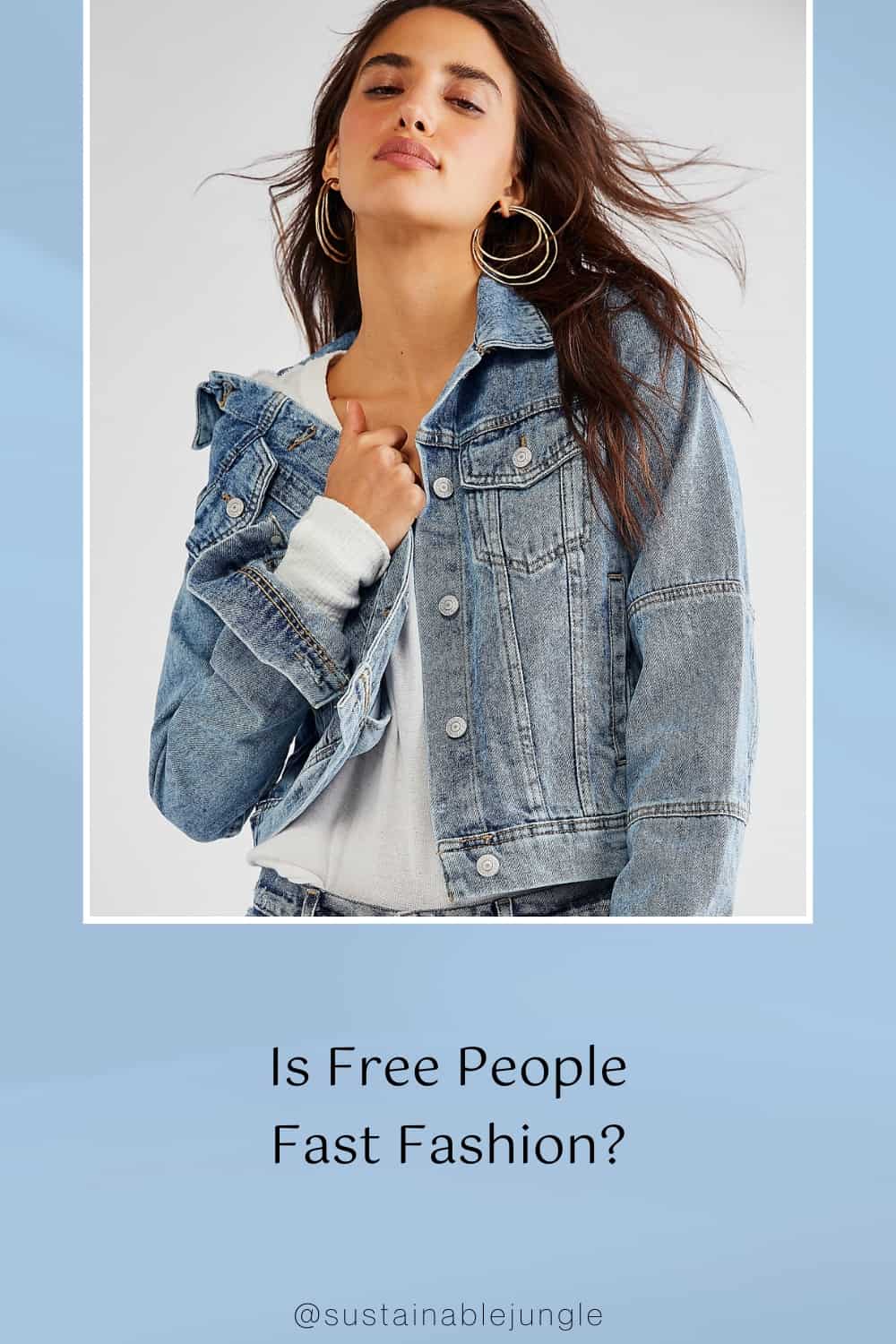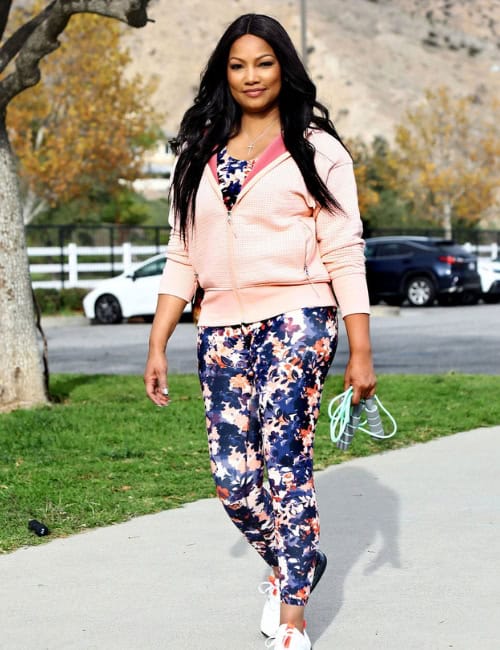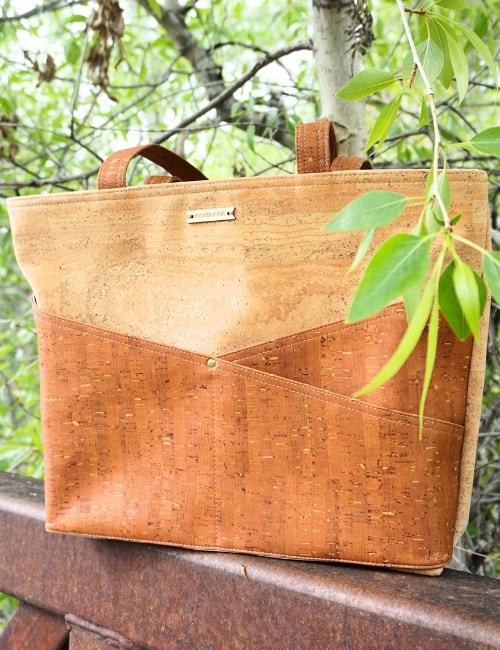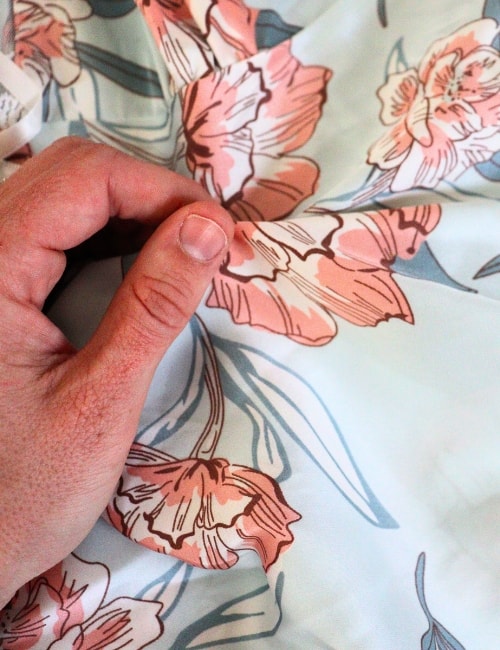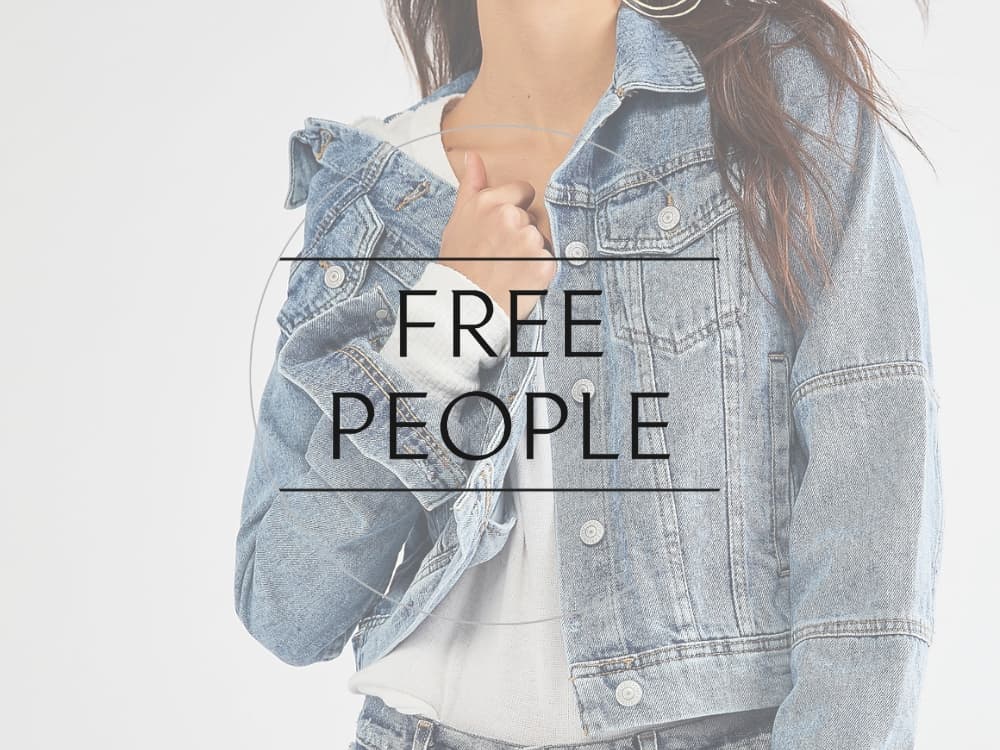
Is Free People Fast Fashion?
With their fluttering bohemian dresses, vintage-inspired lace bralettes, funky festival fashions, and earthy goddess vibes, Free People seems like a brand that cares about sustainability, people, and the planet.
But is their free-spirited vibe merely a guise?
Beneath the boho, is Free People fast fashion flaunting itself as a freewheeling earth child?
It may come as a shocker, but Free People is not sustainable….
Which naturally raises eyebrows about the high price tag attached to their wares.
One quick peruse online finds dresses for $200+ range and tops and bottoms for $100+.
A company is obviously fast fashion when their prices are pocket change (we’re looking at you, Shein), but Free People’s prices match what most sustainable brands who ethically source and pay living wages to supply chain workers would charge.
So, what’s the deal? Is Free People sustainable or just another example of greenwashing galore?
How ethical is Free People, really?
1. Uncovering Why Free People Is Fast Fashion

While their clothes are intricately designed and sold for premium prices, Free People is still fast fashion.
For starters, their “New” section currently has 1294 items listed, and their “New Today” page features 145 new garments in just one day—far too much on a planet with no plan(et) B.
And this is just the start when asking, “Is Free people legit?”
Perhaps the brand began as legit—back in the 1970s in Philadelphia, when Dick Hayne started a cool counterculture shop with records, plants, secondhand, and some hippy clothes.
The store embodied the spirit of 1970s freedom, rebellion, and self-expression. A few years later, it expanded as a chain and renamed itself the now-iconic Urban Outfitters. In the mid-1980s they revived the Free People label, this time as an inhouse brand.
And now who owns Free People?
Today, they operate as a label and a store under the retail powerhouse URBN, who also own Anthropologie, Urban Outfitters, and others.
Free People is sold in over 1,400 specialty and flagship stores around the globe.
While the brand began as a part of the counterculture, unfortunately it has cemented itself as part of the ugly fast fashion status quo thanks to its closeted malpractices and many controversies.
Good on You gives Free People a “Not Good Enough” sustainability score of 2 out of 5, and the Fashion Transparency Index gives it a meager 11% to 20%, indicating there’s huge room for improvement when it comes to FP’s ethical and sustainable practices.
Through its Care FP line and careful online messaging, Free People claims to care for the planet and people.
But as they continue to pump out short-lived trends and manufacture volumes of resource-intensive clothes with little regard for workers, it’s hard to understand how Free People is really Earth-friendly.
They may not be fashion’s worst offenders, but there’s more than room in their artisan-crafted bell bottoms and premium muu-muus for improvement.
2. Free People Controversies

In 2021, Free People parent company URBN bragged online of its record sales and profits, which is chilling (no FP chunky knits to warm us, thanks) given their long history of wage thefts, shoddy workers rights, and poor manufacturing ethics to get there.
Off the backs of utter exploitation this brand has built its faux-image of peace, love, and free-flowing haute-hippy gear.
Here are their top controversies to date:
Rana Plaza
The dangers and true cost of fast fashion first hit headlines in 2013, when the deadliest garment factory disaster in history occurred.
The 2013 Rana Plaza collapse killed more than 1,100 underpaid and unprotected Bangladeshi garment workers and left an additional 2,500 seriously injured, many of whom were permanently disabled.
Free People, along with its sister company Urban Outfitters, were two known labels the factory was sewing at the time.
While many large retailers joined forces to address unsafe working conditions in the developing countries where they outsource manufacturing, Urban Outfitters and Free People refused to join this movement.
Unpaid Wages
Not only is FP embroiled in the aforementioned deadliest manufacturing disaster, but also the largest workers’ wage theft in fashion history.
When COVID-19 halted sales worldwide, most fast fashion brands canceled their orders with garment factories, leaving suppliers and their workers in an enormous financial lurch with unpaid wages for clothes that were already sewn and ready to ship.
To date, URBN refuses to pay. There’s even an online tracker by the Workers Rights Consortium to follow who has and has not paid up along with a popularized online PayUp campaign.
The Guardian reports the outstanding bill is a whopping $16 billion, of which at least $220 million URBN is responsible for.
So how much does Free People pay their garment workers?
They don’t say, but we’re fairly certain they aren’t making fair trade wage history.
This becomes all the more eyebrow-raising when we stack it against the messaging on Free People’s website, where they feature a “To Our Community” page highlighting “our ongoing, and future commitments toward equality – in support of YOU, our Community…”
Even more greenwash-gaslighting is that to celebrate their “assistance to workers during COVID times”, they advertise “to the community” how they donated 70,000 units of hand sanitizer to the Latinx nonprofit Mercado Global, supporting Indigenous female weaving communities in Guatemala.
TLDR: they were partially responsible for Rana Plaza and owe part of the unpaid BILLIONS in wages during the pandemic, and they promote “equality” with all the hand sanitizer they donated in Guatemala…
So is Free People a good brand?
Those facts alone speak vintage-inspired volumes.
Sweatshop Factories In LA
Just prior to the implementation of the California Supply Chains Transparency Act, Free People was also caught in a domestic garment workers scandal by using and abusing illegal workers in LA sweatshops.
In 2016, the US Department of Labor investigated the LA garment industry, finding labor violations in 85% of the 77 factories randomly inspected.
They found that more than 80% of garment workers in Los Angeles have experienced wage theft and these factories were concluded to have “sweatshop” conditions.
We can’t find any statement from FP or UO in response to these sweatshops.
Child Labor
Anthropologie and Urban Outfitters child labor scandals are well publicized, which makes us wonder about the very un-transparent practices of Free People.
While URBN says it commits to no child or slave labor, a lack of evidence paired with reports and petitions that highlight concerns about sweatshops and factory conditions means that child labor is a Free People controversy, too.
For example, this petition from 2011 urged UO (and directly addressed the then-president of Free People) to stop using Uyghur child labor for cotton.
Similar to Old Navy (and their parent company’s) lack of transparency or reliable certifications when it comes to their supply chains, we simply have no idea whether Free People’s production pipelines include child labor or not.
Design Theft
Once one of our favorite sustainable fashion brands, tonlé, penned a heartfelt exposé on Remake/World after discovering Free People stole their designs.
Sadder still, tonlé has since closed.
Writes co-founder Rachel, “Plagiarism is not a design flaw. It’s a persistent part of the fast fashion system, and we need to talk about why that matters.“
It’s especially a low-blow for Free People to rip off tonlé, given they hired them as Free People designers in the past, and secondly, because Tonlé was everything Free People is not: a zero-waste, traceable, ethical fashion brand producing apparel from factory remnants to promote circularity.
Rachel explains,
“In this case, the design Free People stole from us was more than a copy of our pattern.
It was a theft of our weaving technique, something I personally spent months developing with artisans.
Not only that, but the original color comes from a natural plant-based dye that is indigenous to Cambodia, a color I learned to make from Cambodian master-craftspeople.
All the development work that went into this piece would have been impossible for Free People to do on their own.
Instead, the brand requested a sample from us, and then copied it.
That saved the company thousands of hours of work in not only designing the garments, but also developing the process to make them.
To add insult to injury, Free People’s copy also stripped the design of the piece’s original Cambodian name, Phnom Vest (meaning mountain), and changed it to an anglophone, self-indulgent name, the Always You Top.”
Racial Profiling In Stores
During the Black Lives Matter movement, it came out that many employees working for the URBN portfolio were trained to spot and monitor Black shoppers, and gave them the nickname “Nicks”.
As a result, A-list celebrity Emmy Rossum came out publicly to apologize for wearing “stupid Free People bralettes” on the hit TV show Shameless.
Cultural Appropriation
In 2016, FP was lambasted for cultural appropriation of traditional Native American wares for festival fashion.
As an aside, Coachella Festival also sued them for stealing the Coachella name and diluting the Coachella brand with a number of these festival items.
Products were profitless for the marginalized communities they stole from, inauthentic, and outrageously priced: we’re talking $180 “spirit animal” essential oils, $110 “medicine pouches”, $96 rain sticks, $70 beaded chokers, $280 ear cuffs, and $350 feathered headdresses.
It wasn’t Free People’s first controversy related to cultural appropriation, either, with the brand blasted two years prior for selling clip-in dreadlocks with an online dreadlock tutorial.
3. Free People Ethical Issues

If the knickers-twisting summary of Free People controversies wasn’t enough, then let’s dress down their many ethical quandaries.
Is Free People clothing ethical and cut from a different cloth than fast fashion, or will we unbutton the ‘same old’?
Free People Labor Practices
Free People has yet to start any kind of sustainability annual reporting, but they claim to do so via URBN, who first made an impact report in 2022 (link is broken online) and then in 2023, with a shortened “Impact Scorecard” and no full report.
While URBN’s report states their plan to improve supply chain transparency, that in itself provides no transparent or traceable roadmap toward this target or how they’ll measure it.
We’ll simply have to wait and see if this really pans out.
Due to the California Transparency in Supply Chains Act, FP now provides a statement, in which they outline the bare minimum to ensure no human trafficking or slavery in their production pipelines. They say audits both announced and unannounced occur, but fail to pay a reputed certification body to ensure their supply chains are “clean.”
In the “Certification” sub-section, they declare Free People Suppliers “certify that they will conduct business in compliance with the law…”
Huh? Certify how?
According to the vague document that is URBN’s “Modern Slavery Act Report 2023,” they are taking steps to ensure better traceability of supply chains, so we’ll have to wait until next year to see if they really fulfill the targets listed.
Free People Supply Chains
Where is Free People’s clothing manufactured?
While they say they are working with Better Cotton in Turkey now, they also mention dozens of other countries where they have factories and farms whose processes we have no idea about:
“Factory partners are in Bulgaria, Canada, China, France, India, Indonesia, Italy, Mauritius, Morocco, Portugal, Romania, Spain, Sri Lanka, Taiwan, Thailand, Tunisia, Turkey, United Kingdom, and Vietnam. Plus, three new countries have been added in the last year: Cambodia, Egypt, and Pakistan, where partners have worked to diversify their own supply chains post-Covid.”
Again, a whole lotta nothing.
Especially when you pair this with their 21% score in the latest Fashion Transparency Index and their lack of manufacturing certifications in their supply chains.
While the brand does publish some info regarding policies and audits, without a comprehensive list of suppliers, audit results, or even published stances on forced labor, gender equality, or freedom of association, we can only assume the ickiest.
Then there is their Bali Collection—a perfect example of appropriation and greenwashing.
Here, they claim to be sustainable and ethical while exploiting traditional Balinese artisans, and without any mention of environmental practices at factories, certifications, audits, whether they pay artisans adequately, if they do extra to support the community, ethical sourcing, and more.
Items from this line sell for hundreds and hundreds of dollars. How much does the garment worker see?
A good start to rehabilitating Free People ethics would include an honored living wage for workers and releasing its suppliers to the public, along with improving conditions (with traceable evidence) across its supply chain.
A large company like Free People/URBN can also easily afford reputable certifications like Fair Trade, SA8000, Climate Neutral or B Corp to legitimize their ethics—especially since URBN is one of the biggest offenders of wage theft in California.
Free People Animal Welfare
Recently, UO & FP generated further controversy by offering a “free kitten” giveaway with purchase, with citizens genuinely concerned for the wellbeing of these pets being adopted alongside a fast fashion purchase.
Free People also partners with the Best Friend Animal Society to raise awareness for shelter animals, and committed to a $100k donation. They even pledge to save ALL the shelter animals in the US from slaughter by 2025, though how they will do this is unclear.
Even more absurd is all the animal products they sell (from likely-inhumane processes) while talking about saving and adopting animals.
While Free People went angora-free in 2016 as part of URBN’s larger choice, the brand still uses wool, leather, and exotic animal hair from unspecified sources.
Due to the lack of transparency, the welfare of both the animals and workers cannot be guaranteed if the brand cannot trace items back to square one.
PETA advocates call their attempts at animal welfare mere greenwashing.
Free People needs to start tracing the sources of its animal-derived materials to ensure they’re ethical, or better yet, introduce a zero-animal policy instead of their “we love animals” sales trick.
4. Free People Sustainability Issues
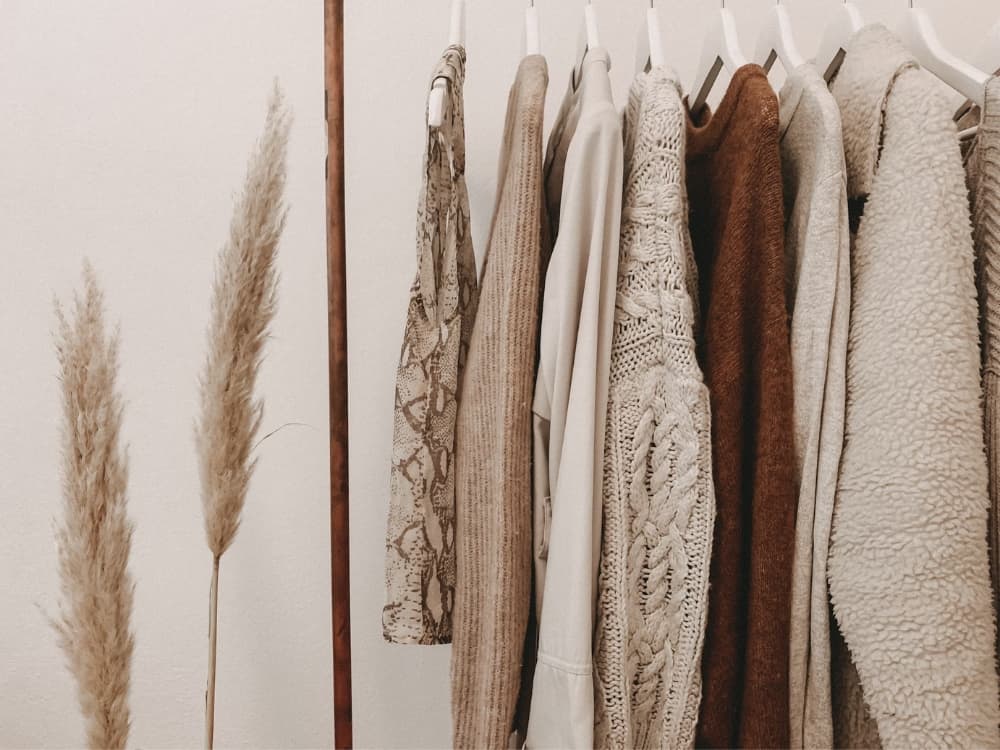
We’re not convinced the brand’s ethics match their high prices, but is Free People a sustainable brand?
The brand made tangible progress in recent years when it comes to mitigating its impact on the Earth, although there is still plenty of room for improvement.
The Free People mission statement on their sustainability page says,
“Care FP is Free People’s mission to do a bit better—because we believe every step counts. From the social impact we strive for, to the footprint of our work, to our non-profit partners and connection to our community, we’re making conscious choices—both big and small—to protect our planet.”
So let’s roll up our sustainable sleeves to investigate how this statement stacks up:
Free People Environmental Impact & Manufacturing
Under their Care FP x Mother Nature section, they talk about better choices, responsible sourcing, waste reduction, resource preservation, product standards, and their promotion of circularity “with the goal of moving from a linear model into a regenerating one”.
On the plus side, FP’s distribution center is “one of the country’s largest rooftop solar arrays for on-site power generation” and generates enough power to almost be entirely self-sufficient.
Reportedly it saves 108,956 gallons of gas, 965 tons of CO2, and 24,212 trees per year.
Although this is a positive commitment to renewable energy, FP gives no evidence that this ethos carries throughout its supply chain.
Likewise, we see no evidence that Free People prevents deforestation, reduces hazardous chemicals, minimizes synthetic production from petroleum, or lowers its water usage in its supply chain.
Much of their website is just clever marketing claims.
For example, they highlight their polybags as being “reusable” like they’re doing something good.
But in reality, they’re still entirely landfill-bound and neither traditionally recyclable or biodegradable if you don’t want them anymore.
Free People Materials
Their website allows you to search items by ‘artisanally made’, ‘responsible materials’, ‘reusable products’, and ‘vintage clothing and accessories’—all of which indicate they want to be seen as a sustainable brand
Through their Care FP line, Free People has introduced an array of lower-impact “responsible materials” like organic cotton, recycled cotton, recycled polyester, and cellulose-based fabrics, which they say are “‘small-batch made by 501(c)3 nonprofits who support artisanal and small businesses, both overseas and in our own backyard.”
Yet, with zero traceability or sustainability certifications to back this up, we have no way to verify these claims.
They also partnered with FABSCRAP to recycle 1500 pounds of landfill-bound textiles alongside the other URBN brands.
But with 92 million tons of clothing scrapped annually, their 1500 pounds across ALL THEIR BRANDS is more like a pilot project than large-scale action, which is desperately needed.
Free People vintage is another way they’re addressing circularity and materials, by selling premium secondhand items.
At the time of writing, their website showed that of their 3000 total products, 597 were artisanally made, 259 had responsible materials, 32 reusable products were available, and just one vintage product was for sale.
Most of their 3000 items sold (especially their Movement yoga line) are still made from virgin nylon and polyester—two popular synthetic fabrics in the fast fashion industry with massive environmental impacts in terms of chemicals, energy and water usage, microplastics, petroleum extraction, and poor end-of-life.
Free People Carbon Footprint
Parent company URBN has fortunately lowered its carbon output across its portfolio of brands.
This includes some use of lower-impact textiles, reusable shopping bags, energy efficient LED in-store lighting, improved shipping fuel efficiency, and renewable energy at the brand’s direct operations.
However, there is no evidence FP reduces carbon and other GHGs along its supply chain.
Ssnce the fashion industry’s environmental impact stems mostly from manufacturing and transportation, a comprehensive sustainability strategy would address emissions throughout the entire supply chain.
We’re also concerned about the apparent lack of efforts to manage hazardous chemicals, water usage, and wastewater, since these are all crucial to minimizing the impacts of fashion production.
While the brand splashes “circularity” across its website marketing, when you’re still producing THAT much virgin plastic clothing, not much of your offsetting will do any good to your massive carbon footprint unless you simply STOP making and selling so much fast fashion.
Did you know we Have a Newsletter?
We cover the latest in sustainable living, fashion, zero waste, beauty, travel, finance and more…
Final Thoughts On Is Free People Ethical & Sustainable?
Free People is a bummer because they started out in the 70s as changemakers and trendsetters voting for people and the planet.
But today, they chase fleeting trends and manufacture scores of resource-intensive clothes for outrageous prices, making it difficult to understand how Free People can be eco-friendly if they don’t embrace a truly sustainable business model.
So, is Free People fast fashion?
Aside from their ridiculously inflated price-points, everything about the brand is fast fashion.
Despite Free People’s branding that it cares for the planet, community, and artisanal-quality apparel, their short-lived trends, volumes of resource-heavy clothes, and questionable ethics around humans and animals makes it hard to believe they’re really ANYTHING-friendly.
And as part of a multi billion-dollar fashion conglomerate, they simply must take responsibility for their operations and environmental footprint.
The next time you’re shopping for your fill of prairie girl dresses or whimsical blouses, we encourage you to shop sustainable dresses and the like instead—especially since most sustainable brands fall in a similar price range.
Or for the best value, try second hand stores!
Have that faux-hemian friend who falls for FP’s faux-eco feminine wiles?
Send them this article to support a more just and sustainable fashion industry for all.
Pin these:

